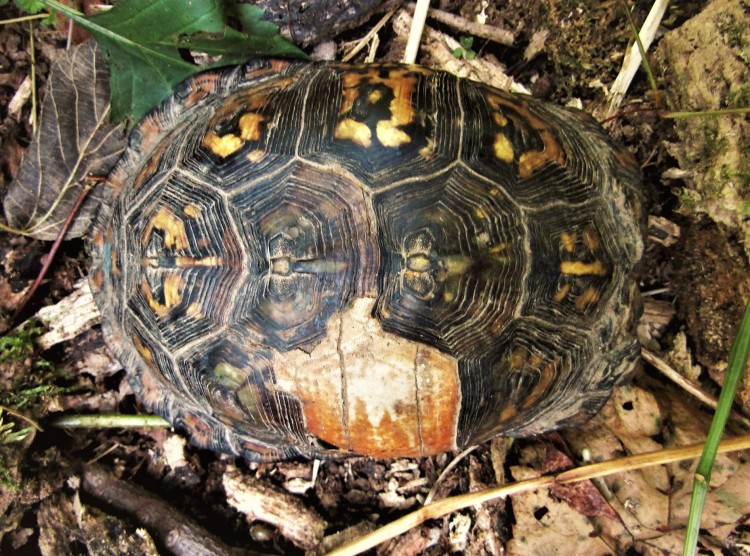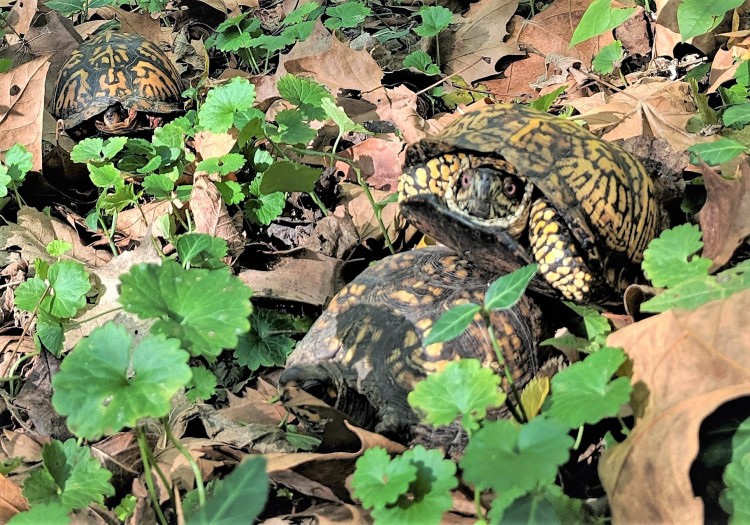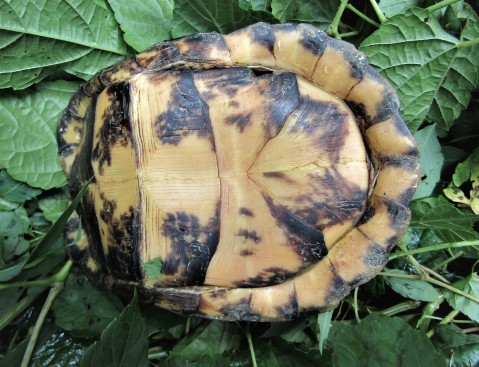
As the spring and early summer heavy rains gave way to heat and drought, Box turtles were a little less active. On 7/30 I encountered this large male, one of the most strikingly patterned turtles I’ve ever observed. He was near the edge of the preserve and a busy road, and unfortunately rather boxed in (excuse the pun) between the road, the deeply channelized creek and open, mowed parkland. It leads me to wonder how he came to be in this little island of habitat – is it part of his home range or did he come here seeking a mate? If he wandered in from the forest, he had to clamber down a very steep bank, swim the creek, and climb back up the equally steep far bank.

This pic shows the carapace of the same turtle, also highly patterned. I understand the value of the great variety of Box turtle scute patterns on the upper shell – but why on the underside too? Science has not explained this to my satisfaction (and I have searched for studies). It remains a mystery why Eastern Box turtles have such strikingly varied, and often asymmetrical plastron patterns. If these turtles were spending a lot of time on their backs, it might make sense as camouflage – but even so the underside patterns are often considerably more bold and striking than those on top. The only time I have seen a Box turtle voluntarily exposing its plastron is during mating, when the male leans back to facilitate coitus.
The images above are a sampling of plastron patterns on Box turtles in this forest. Studying the pics closely, I realized that the posterior end of each scute or scale is dark pigmented. This dark pigment creates a pattern on each scute that often, but not always, has bilateral symmetry. It can be quite varied from turtle to turtle, ranging from very clear-cut pattern blocks, to more wavy or flame-like displays. The range of plastron patterns is quite a bit more diverse than those found on the carapace. When I encounter a Box turtle in this forest, I often can remember if I’ve seen it before by looking at the underside pattern.
Of the five Terrepene carolina subspecies found to the south and west, three are relatively dull and muted above, and mostly featureless below. The Ornate and Florida subspecies are very crisply patterned above and below in a more linear, symmetrical way, suggesting their habitat is relatively open and grassy. But none have the degree of variation, above or below, of the Eastern box turtle. There is however another North American turtle with a plastron puzzle – of the four subspecies of Painted turtle, only the Western subspecies has a colorful and varied pattern below. Conceivably this would communicate a message to other turtles swimming below it, yet the Eastern, Midland and Southern Painted turtle subspecies have dull pale undersides. Evolutionary biologist Jeff Mitton noted this difference and blogged about it:
https://www.dailycamera.com/2011/06/23/jeff-mitton-the-perplexing-pattern-of-the-painted-turtle/

Besides plastron patterns, other unique markers such as missing scutes, healed injuries, and bright pigmentation can help me remember if I’ve previously encountered a Boxie. I met the older male above on 9/8 in the mid morning – my notes say 86 degrees and “hot”. He pulled in his orange head when I approached, but the deep pigmentation and damaged scutes jogged my memory.

Sure enough, he’d last been recorded in 2014, and not very far away. That’s him sitting on my notebook.

On 9/21, another hot dry day, I came upon these two in the middle of the dusty trail. The female is wearing a transmitter, and it had apparently been reglued since there is dried epoxy on her carapace. They’re not mating yet – the male is just “courting”, which often consists of biting her on the head and the front of her shell. I left after taking the picture, so I can’t say whether they hit it off or not.

I had the good fortune this summer to see some relatively younger and older Boxies, in contrast to the mostly middle aged population. Older females, like the small one above with the very worn carapace, are particularly uncommon. The smooth condition of her shell and loss of pattern complexity are markers of advanced age. Unlike many of the females I saw this year, she was in the forest interior, far from any edges – perhaps a clue to her long survival!

The pic above shows her underside, equally worn and pitted by all the years of walking across the forest floor and navigating over and under obstacles. How old could she be? For a reptile with a lifespan analogous to our own, I would guesstimate her age at sixty to eighty years.


On the younger end, the two Boxies above appear to be less than ten years old. The orange pigmented one was only four inches long, and both have the blurry, still developing scute pattern and knobby ridge atop the carapace, that indicate an immature Box turtle. Young turtles are particularly vulnerable to predation since their shells are smaller and thinner, and easier for teeth to penetrate.

On 10/14, while cutting Bush honeysuckle near the creek with a few other forest stewards, I almost stepped on one of the most beautiful Box turtles I’ve ever seen.

His underside pattern was pretty amazing too.
And now for the numbers – I recorded 41 observations of Box turtles for 2019, making a total of 250 sightings over 7 years. None of these were found by searching, just encountered in the course of daily forest restoration work. There are a lot of turtles in this little forest, but as time goes on it’s clear that some turtles are being recorded multiple times. Some boxies just seem to be out and about more, in well traveled areas, so are recorded more often. The challenge is to compare the various sightings and determine just how many individuals there are. The gender ratio this year was 19 males, 22 females, and 6 turtles too young to sex accurately. Those six are a very hopeful sign for the future.

On 10/20, the last turtles of the year – proving that for male boxies anytime is mating season.






Jim Sky
Thanks as always for the post. I really look forward to them.
Just thinking out loud here, not lecturing.
Not all characteristics an organism possesses provide an evolutionary advantage. Many characteristics are benign (sometimes even disadvantageous) holdovers from the evolutionary path of the species. Some genes survive from our earliest ancestors, riding along as junk DNA until some selective pressure re-ignites them. Often traits seem to be linked with others. I think about coat patterns in those famous Russian Silver fox domestication experiments. Selecting for more tame foxes produced foxes with coat patterns we see in domesticated wolves (dogs). So those coat patterns probably existed in the common ancestor to wolves and foxes. Selecting for one traits cannot be necessarily untangled with selection for other traits. Something regulating Eastern Box turtles fitness other than coloration may be driving the seemingly wasted coloration of the of the plastron. Or Not! Having the genes to express color patterns anywhere is important. What is the selective pressure to have those genes repressed for the underside? Having a bottom different from the top could require a more complex morphogenetic pathway than just allowing color to be expressed everywhere. So perhaps our urge to establish the evolutionary advantage of some traits is unwarranted. Some of nature’s most beautiful works may rely heavily on the random accidents of its brush.
https://www.ncbi.nlm.nih.gov/pmc/articles/PMC2763232/
LikeLiked by 1 person
oneforestfragment
Interesting reasoning – I agree, the plastron variability is not necessarily a fitness or selection issue. The capacity for variation described in the fox study is likely not unique, and there’s a lot more to learn about gene expression, switching on or off, etc. Perhaps the evolutionary history of boxies would be enlightening as well. My sample size is rather small as well, it would be interesting to see what plastrons look like in other populations. If you recall from my last post, researchers were surprised to see no evidence of population structure in a large Indiana Box turtle study. So there is, or was in in recent times, considerable gene flow between populations of these seemingly sedentary animals.
LikeLiked by 1 person
Jeff
As a person what has been photographing and observing Box Turtles for decades, I really appreciate the work you are doing. Please keep providing this outstanding information. If you ever want/need additional Box Turtle photos I have (literally) thousands of images. I’ve been monitoring a population in the Nelson County, Ky. area for many years now.
LikeLiked by 1 person
oneforestfragment
Thanks Jeff! Have you organized your data in any way? Monitoring them for so many years could yield some interesting insights.
LikeLike
shoreacres
I’m always learning things here, and this time it involved scutes. I’ve always associated that feature with our alligators, but I see the meaning is broader. I’m off to learn more about them in turtles — and birds.
LikeLiked by 1 person
oneforestfragment
As a fellow blogger, I know you can relate when I say I’m the one learning the most – the blog makes me dig in deeper. Scales to feathers, you’ve inspired me to learn more too!
LikeLiked by 1 person
shoreacres
When I started blogging, I thought the “rule” to “write what you know” was silly. If I only wrote about what I knew, I’d run out of topics pretty darned fast. As it is, I’ve learned more than I ever could have imagined!
LikeLiked by 1 person
oneforestfragment
Great point! Admittedly, I wouldn’t have been able to write about these topics when I was younger even though I considered myself something of a naturalist. All we had then was field guides – now I pose the questions to my research assistant Google.
LikeLiked by 1 person
Deany
Love this post, as always, learn a lot.
LikeLike
Anonymous
Thanks for all the interesting information and beautiful pics. You’ve made my 2019 much richer!
LikeLiked by 2 people
oneforestfragment
You are welcome – that is so great to hear. My readers keep me inspired!
LikeLike